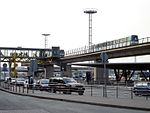Rungis
Communes of Val-de-Marne

Rungis (French pronunciation: [ʁœ̃ʒis] (listen)) is a commune in the southern suburbs of Paris, France, in the département of Val-de-Marne. It is best known as the location of the large wholesale food market serving the Paris metropolitan area and beyond, the Marché d'Intérêt National de Rungis, said to be the largest food market in the world. The name Rungis was recorded for the first time in a royal charter of 1124 as Rungi Villa.
Excerpt from the Wikipedia article Rungis (License: CC BY-SA 3.0, Authors, Images).Rungis
Rue de la Pirouette, Arrondissement de L'Haÿ-les-Roses
Geographical coordinates (GPS) Address Nearby Places Show on map
Geographical coordinates (GPS)
| Latitude | Longitude |
|---|---|
| N 48.7483 ° | E 2.3497 ° |
Address
Rue de la Pirouette 11
94150 Arrondissement de L'Haÿ-les-Roses
Ile-de-France, France
Open on Google Maps









